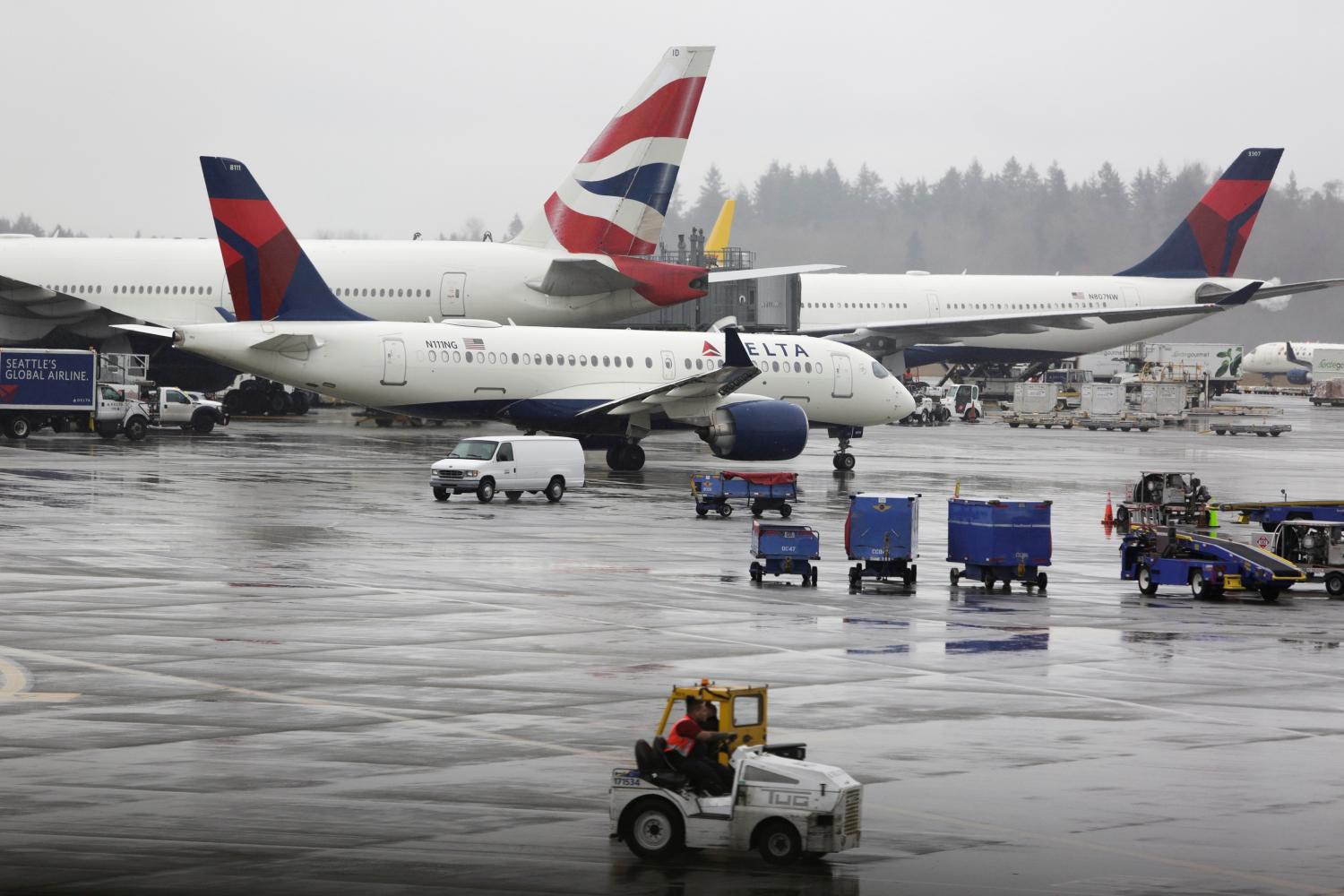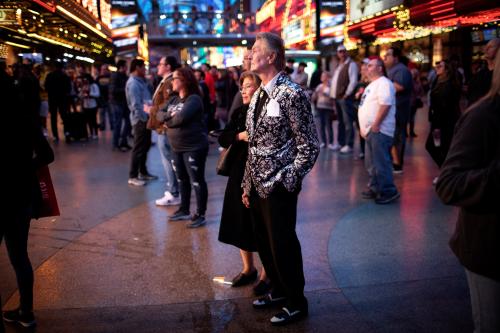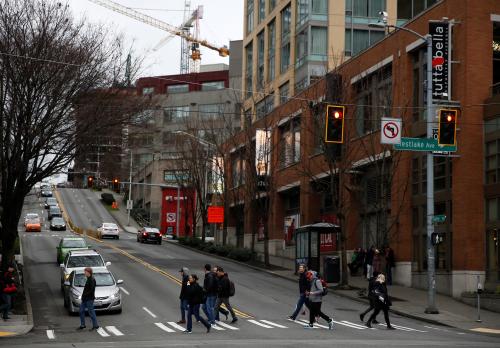The coronavirus pandemic has thrown America’s aviation industry into genuine chaos. Planes are flying with only a handful of passengers. Terminal halls are desolate. Customs processes overwhelmed. But most Americans don’t even fly once a year, meaning a struggling aviation industry can seem like a problem strictly for business travelers and select vacationers.
Yet aviation is not a luxury industry. Vast segments of our economy are built on the expectation that tourists can fly to their destinations, businesses can host face-to-face meetings, and shippers can deliver the latest smartphones and fresh flowers to stores. Whether you board a commercial plane this year or not, aviation touches your daily life.
That’s why we all need to worry about this shocking decline in aviation demand. In the immediate term, a specific set of large metropolitan areas could feel serious workforce impacts as airports, airlines, and freight companies struggle with severe liquidity crises. In the months to come, even after the virus is under control, a broken aviation industry could still make it impossible to return to economic normalcy.
The aviation industry, financiers, customer rights groups, and the federal government will likely settle on some form of financial support—a bailout—for this essential industry. But will they focus on the right tactics?
What does the coronavirus mean for aviation?
Viruses and aviation don’t mix well. Airports are queuing machines, placing people coming from miles apart into close proximity with one another: passing through security, buying food, boarding the plane, and, for international travelers, clearing customs (which, as we saw at U.S. airports after the newest travel bans were enacted, created a fiasco). The coronavirus can also live on metal, wood, and other hard surfaces that airports and airplanes have in abundance.
Governments, airlines, and consumers know this. It’s why generous rebooking options, formal travel restrictions, and general customer awareness are now keeping people away from airports. U.S. airlines have already started to cut domestic flights by around 30% and international ones by roughly 70%, with reductions expected to last at least until summer. We don’t yet have systemwide traveler data, but early numbers out of Seattle and Orlando suggest the industry will see much lower load factors (the share of seats filled with passengers) than a year ago this month.
Less travel keeps us all safer in the midst of a pandemic, but it has a real financial cost for airlines and airports. Passengers provide most airline operating revenue, primarily in fares plus ancillaries like those pesky baggage fees. While some revenues can continue—including income from frequent flyer programs—there’s no antidote for losing what could be hundreds of millions of passengers in just a few weeks. Airports primarily make money through landing fees from airlines, terminal store rents, and parking. All those revenue sources will also be decimated without travelers.
The coronavirus plays a bit different in the air cargo industry. Trade lanes are still open at airports, but moving cargo requires workers in factories, on-the-ground logistics, and retail to bring goods to market. Shippers don’t like moving empty vehicles, so imbalanced trade can drive up costs and timelines for everyone.
However, there is one bright spot: oil prices. For those airlines not stuck with futures contracts that lock-in older prices, sagging demand will lead to much cheaper fuel. Once quarantines and travel bans lift, if prices stay low—which should be the case if we’re in a national or global recession—then airlines and travelers will get at least one financial break.
Which metropolitan labor markets are most exposed to aviation shocks?
If customers don’t buy tickets and businesses don’t buy goods, then planes don’t fly. And if planes don’t fly, then the entire industry will look to cut costs wherever possible. That places over 740,000 workers at risk: Pilots, flight attendants, baggage handlers, and many others could feel the economic effects of any coronavirus disruptions.
That labor risk will primarily impact the country’s largest metropolitan areas. The 10 most populous U.S. metro areas house 48% of all employees in those occupations, and the share jumps to 71% when looking at the 25 most populous metro areas. This far outweighs their share of total U.S. employment.
Aviation employment concentrates in relatively few places. Economists measure that concentration using the “location quotient” statistic. The location quotient is greater than one in metro areas where a higher share of people work in a given industry than the national average; it is less than one where that share is smaller. Metro areas such as Charlotte, N.C. and Salt Lake City have high concentrations of aviation jobs because they are hubs for large domestic airlines. Las Vegas and Orlando, Fla. rely on aviation to feed their tourism industries. Global hubs such as Atlanta, Chicago, and Miami rely heavily on aviation to power their logistics industries.

While we won’t know the labor market outcomes for weeks or months, we do know that layoffs will have ramifications outside of aviation. Aviation is what regional economists call a tradable industry; it brings income from consumers in other places into a local market, which helps generate additional, local-serving jobs. If airlines, airports, and shippers cannot keep people employed—and if unemployment insurance doesn’t offer an adequate safety net—then employment losses in aviation will multiply income losses across a metro area.
How should the federal government help the aviation industry?
We live in a global economy, meaning our core demand for air travel will not disappear once the pandemic subsides. The real concern is how long it will take for the aviation industry to rebound. Aviation demand relies on a complex amalgamation of factors: firms executing trades, businesses scheduling meetings, consumers booking trips, and the providers (passenger and freight firms) having the financial capacity to offer their services. If any of those factors don’t align, then a rebound could take longer than hoped for.
Nor is aviation just another national industry. There are enormous up-front capital costs to establishing airlines and maintaining a network of airports, all of whom rely on a central navigation system for safety and reliability. Aviation also has no direct substitutes—fast, dependable passenger railway travel is nonexistent in most of the U.S. Due to a mix of scale economies and lack of competition, if an airline goes out of business or stops servicing a specific metro area, then travelers have no clear way to quickly reach those markets. Such service losses would not be easy to address.
This is where a federal bailout comes into play. Aviation is essential infrastructure, creating untold benefits for the entire economy. We, as a country, need aviation providers to have their planes, crew, and support staff ready as soon as possible. Likewise, we also need people and businesses to feel confident in the aviation industry, since that confidence will lead to them booking business.
This is all eerily similar situation to the last big shock to the aviation system: 9/11. Then, just as today, we witnessed an understandable fear lead to sagging demand. The rapid federal response was a $15 billion bailout of loans and grants to the airlines, which equals about $21 billion in 2019 dollars. The Congressional Research Service found that, even with the assistance, aviation employment and airline financials were still depressed a year later. The industry did eventually rebound, but it’s impossible to know how much worse the situation could have been.
While 9/11 was a short-term shock, the coronavirus pandemic promises to both upend travel for months and potentially induce long-term consumer fear of flying. Already, there are outright bankruptcy concerns coming from airlines—it’s just a question of how bad the damage will be. Just as in 2001, the federal government is the insurer of last resort to minimize the damage.
The silver lining, if there is one, is that the federal government can negotiate from a position of strength. Airlines, shippers, and airports essentially want free insurance, either through grants or low-cost loans. If the government offers support, federal leaders have a responsibility to extract concessions on the behalf of taxpayers who foot the bill.
Fortunately, the public can look to recent lessons from the 2009 auto bailout. That was a larger but comparable case, proving that loans and the feds taking an ownership stake can stabilize an industry in short order. We propose any assistance to the airlines and airports include a few clear stipulations:
- Negotiations must include customer rights groups—not just airlines, airports, and federal officials. Customer rights groups will help represent the needs of the taxpayers who will pay for any bailout in the first place.
- Any airline bailout should strictly include loans, not grants. Offering grants in the 9/11 bailout led to underuse of loans, and a decade of multibillion-dollar profits proves the airlines and shippers can pay back loans. The same goes for airports, where cheaper federal loans could help pay back loans already in place.
- We agree with author Tim Wu and others that any direct financial assistance should trigger a limit on airline stock buybacks for a certain period. Not only do stock buybacks limit cash-on-hand, stocks are likely to lose value during any economic shock, meaning selling company shares is a less valuable source of cash when it’s needed most.
- Any industry-wide bailout should create limits on ancillary fees. Minimizing flight change and baggage fees is a logical start.
- To create future industry resilience for its workers, all commercial airlines should be required to manage a new benefit pool reserved for the next economic emergency, including longer-term health insurance.
- Any federal assistance should trigger an extensive review of the industry as it relates to metropolitan needs. It’s time for a bipartisan committee to review the industry’s structure, how it leads to market power in specific places, and what an ideal structure could be following multiple shocks (and interventions) since airline deregulation in 1978.
We don’t yet have enough information to suggest what size investment the federal government should pass, but the fundamentals are clear: America needs a high-functioning aviation network to reach our economic potential. If we’re getting ready for a bailout, we should ensure it creates a more resilient and fair industry in the process.








